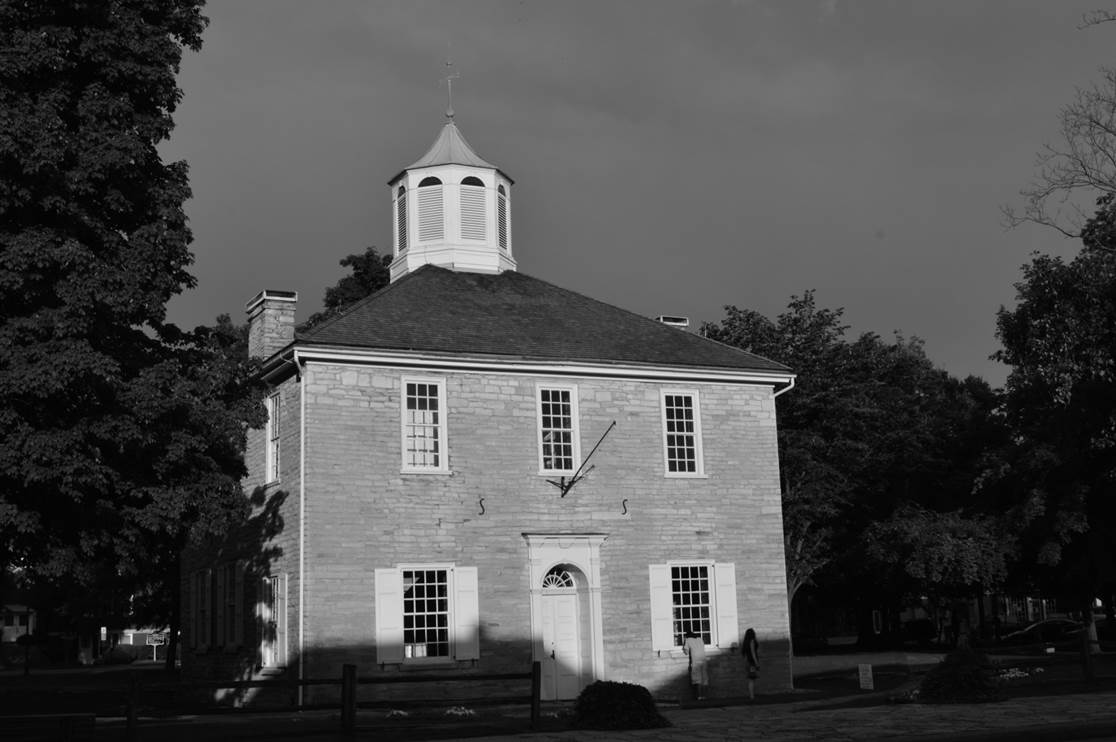- Business & Agriculture
- Residents
- Government
- Education
- Taxes & Finance
- Visiting & Playing
- Family & Health
Bicentennial "Did You Know?" Articles Published in the Corydon Democrat

At the request of former Indiana First Lady and publisher of the Corydon Democrat Judy O’Bannon, Karen Schwartz, president of the Historical Society of Harrison County, has been producing 37 “Did You Know” articles on topics of interest from Harrison County’s rich history. These are published monthly on the editorial page in the Corydon Democrat, Corydon’s weekly newspaper. Ultimately, the articles will be bound into a booklet that will be available for a donation to the Historical Society of Harrison County. The articles provide invaluable information and documentation, covering a wide range of topics.
Q&A with Legacy Project Coordinator Karen Schwartz
What do you consider the key accomplishment of your Legacy Project?
- Articles on topics from Harrison County, Indiana's rich history were printed monthly from 2013-2016 in the "Corydon Democrat."
Describe a highlight or most memorable moment related to your Legacy Project.
- Numerous contacts and positive feedback concerning the projects were received.
How/where are you preserving information and artifacts related to your Legacy Project?
- The articles are available on the Corydon Democrat archives at www.corydondemocrat.com (search Karen Schwartz) and in the Fred Porter Griffin Center for History and Genealogy at 117 W. Beaver Street in Corydon. Text of the articles were also compiled into notebooks available for a donation to the Historical Society of Harrison County.
Total number of volunteers who participated.
- One volunteer.
Estimated total attendance.
- 1,000+ (Readership of Cordydon Democrat)
Project Details
- Organization: Historical Society of Harrison County/Corydon Democrat
- County: Harrison
- Contact: Karen Schwartz, 812-736-2373, karengleitz@hotmail.com
- Type: Non-Profit
- Project Number: IBC-HC-429
- Website: www.historicalsocietyofharrisonco.org
"Did you Know?" Brief History
Did you know that Corydon has a rich history dating back to Indiana’s earliest days?
This article is a brief significance of Corydon’s significance during the territorial and capital period (1816-1825) in Indiana’s early history.
Vincennes had served as the first territorial capital of Indiana Territory until 1813. Interestingly enough, Vincennes was designated as a temporary territorial capital and it was understood from the beginning that Vincennes would only remain the capital as long as Illinois and Indiana were joined together in the Indiana Territory. Vincennes was centrally located as long as the two territories were joined together, but when the Illinois Territory was carved off of the western side of Indiana Territory in 1809, this left Vincennes on the western border of Indiana Territory in an extremely vulnerable position in terms of attacks and defense.
The government began casting about for a new territorial capital location. Many of the small towns in Indiana recognized the economic opportunities which would be presented by the distinction of serving as the second capital for Indiana Territory. Contenders included Jeffersonville, New Albany, Charlestown, Vevay, Lawrenceburg, Madison, Salem and others. In fact, the town of Madison offered $10,000 for the privilege. Eventually the town of Corydon in Harrison County received the honor of serving as the second territorial capital of the Indiana Territory. Ironically, Territorial Governor William Henry Harrison was firmly invested in Vincennes and resisted relocation efforts, vetoing the choice of Madison. Harrison had also been heavily involved with Harrison County in early Indiana and owned four pieces of property there including the site of the town of Corydon.
Following the relocation of the territorial capital at Corydon, the people of Indiana began agitating for statehood for Indiana. Despite administrative delays, when the population of Indiana reached over 60,000, the people were authorized to hold an election to choose delegates to attend a convention to discuss creating a state constitution. Thirteen Indiana counties sent representatives to Corydon in June of 1816. The forty-three delegates met in a log structure at the corner of High and North Capital Avenue.
The first order of business was to decide if the assembled delegates were prepared to create the constitution or if the crafting needed to be delayed to a later date. Enthusiastically, the delegates declared emphatically that they were ready to serve as the instrument to complete the constitution process and work started immediately on the first constitution for the State of Indiana. The delegates labored diligently from June 10-June 29th, 1816. The delegates relied heavily on the U.S. Constitution, as well as the constitutions of Pennsylvania, Kentucky and Ohio, as templates.
Notable provisions of the new state constitution included a bill of rights, a reiteration that slavery was prohibited in Indiana, free education through the university level would be available to all and Corydon was designated to serve as the First State Capitol of Indiana until 1825, when a permanent capital would be named. Again, all the small Indiana towns vied for the privilege, but Harrison County had the advantage that they were in the process of constructing a Harrison County Courthouse, extravagant for the time and place, which would adequately serve the needs as a state capitol building. There was also a financial gentleman’s agreement between the town of Corydon and the convention. Many were unhappy with the selection of Corydon as the First State Capital and continually agitated to have the capital moved elsewhere, often clamoring that the accommodations in Corydon were not sufficient to meet the needs of those attending to state business.
A subsequent flurry of construction took place. In fact, nine of the original buildings that existed in downtown Corydon during the Capitol Period (1816-1825) are still here. They are : Adams Payne House, Cedar Glade, First State Capitol, First State Office Building, Harrison Log Cabin, Hendricks House, Heth House, Posey House and the Westfall House.
The new Constitution of 1816 was presented to the people as a fait accompli and they were not given the opportunity to ratify, or modify, any part of the document. In fact, the Constitution was interpreted to mean that the document could not be amended for twelve years which meant no changes could be made until 1828.
As expected, Corydon was bustling with legislative and local action from 1816-1825. Notable events that occurred during the Capital Years 1816-1825 included a visit in June 1819 by President James Monroe and General Andrew Jackson, the Tragedy of the Falls Supreme Court Decision in 1824, ongoing efforts to relocate the capitol, lavish parties at the Governor’s mansion, the construction of numerous buildings and homes, and selection of the new capital site and, ultimately, relocation of the capital to a new site along the White River at Indianapolis.
State Treasurer Samuel Merrill was charged with the responsibility of moving state records and the state treasury to the new capital site at Indianapolis. An auction was held to dispose of furniture and other items which would no longer be needed. The important items slated for transport were loaded into horse drawn wagons. The journey took eleven days with the party spending the night at homes or inns along the way. Adam Sibert, of Corydon, served as one of the transporters.
Life in Corydon changed dramatically as many of the early “movers and shakers” packed up and migrated toward Indianapolis. The capital had gone and Corydon settled sleepily into small town days and ways.




